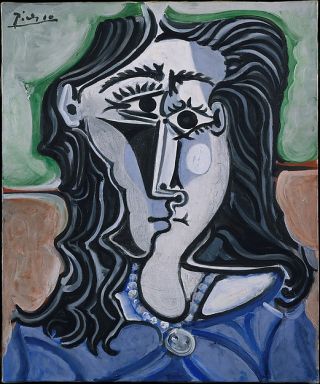Body Image
The "False Creation" of Body Image Distortions
A pilgrimage toward understanding "of its own beauty is the mind diseased"
Posted October 15, 2015

The sentiment “Beauty is in the eye of the beholder” originates from Plato’s Symposium, an exposition on love written about 360 B.C., where Socrates speaks of “beholding beauty with the eye of the mind.” For those with body image distortions, they see not beauty in themselves but imperfections and overt dissatisfaction with their body or parts thereof. Rather, what captures the mindset of these people is a verse from Lord Byron’s early 19th century narrative poem, an autobiographical journey, Childe Harold’s Pilgrimage, (Canto IV, stanza CXXII), “Of its own beauty is the mind diseased/And fevers into false creation.” Those with body image disorders see themselves as though through a distorted prism, not unlike a Picasso painting.

German researchers Hewig et al (Psychosomatic Medicine, 2008) note that body image has two elements—the mental image, i.e., perceived size and shape of one’s body and the emotional aspect of feelings and beliefs. Furthermore, there can be perceptual distortions (i.e., the inability to assess size and shape accurately) and actual body dissatisfaction (i.e., actual negative feelings about one’s body or parts of it.) Didie et al (Body Image, 2010) note that the concept of body image is “multi-dimensional and encompasses perceptions, thoughts, feelings, and behaviors not only about physical appearance” but also about fitness and health.
Some researchers have inferred that our body image is “hard-wired” into the brain, particularly because not only those who have had a limb amputation but even those born without limbs can still experience a “phantom limb” syndrome, i.e., sensations including movement, temperature, pain, and touch in the missing limb(s). Furthermore, there is speculation that the right posterior parietal cortex “plays a critical role” in an integrated bilateral body image: lesions there can lead to neglect of the left side of the body. (For a more detailed discussion of neurological disorders of “self-embodiment,” see Price, Consciousness and Cognition, 2006 and Giummarra et, al, Neuroscience and Biobehavioral Reviews, 2008.) Price believes that a primitive sense of body image begins in utero with spontaneous movements of the fetus and corresponding sensory and proprioceptive (i.e., sense of position of the body) feedback.
Developmentally, though, one’s conscious body image continues to evolve over the first ten years of life as sensory modalities such as vision and touch “contribute to both transient and permanent aspects of body image.” (Price, 2006) Voelker et al (Adolescent Health, Medicine, and Therapeutics, 2015) emphasize that adolescence “represents a critical period for healthy body image development.” Our body image can be influenced by comments from peers and family (e.g. teasing, bullying), as well as from content and images presented in a thin-and youth-obsessed culture. Media tend to promote highly unrealistic, ideal images, and lead adolescents (as well as people of all ages) to compare themselves unfavorably with these images. Dissatisfaction with one’s body in adolescence has been shown to be the “strongest predictor” of the development of eating disorders and disordered eating. (Voelker et al, 2015) Over the lifecycle, though, body image is hardly static and can be affected by pregnancy, menopause, actual disease (e.g. amputation of a limb or breast secondary to disease) or deformity (e.g. congenital anomalies). Of note is that Lord Byron, himself, incidentally, was born with the congenital deformity of a club foot (talipes) for which he was never treated successfully. (For those interested, see Strach’s article in a 1986 issue of Progress in Pediatric Surgery.) Body image can also be affected by aging, when skin loses its elasticity, hair turns grey, adipose tissue accumulates, and people lose muscle tone. Kilpela et al (Advances in Eating Disorders: Theory, Research, and Practice, 2015) note that advertisements for products that supposedly prevent anti-aging communicate the importance of disguising our age and hence may induce conflictual feelings about our body image as we get older.
Body image preoccupations can range from minor concerns with actual “flaws” in our appearance to major fixations and distortions that substantially impair a person’s functioning and reach delusional (i.e., fixed, false beliefs about one’s body) proportions. Both men and women can be affected. A diagnosis of body dysmorphic disorder is made when bodily preoccupations are severe and incapacitating and involve clinically significant ruminative concerns with imagined or perceived slight defects that may not even be noticeable to others. Body dysmorphic disorder will be my subject in a subsequent blog.
What is the relationship of body image disorders to weight? Both excessive weight, as seen in overweight and obesity, and extremely low weight, particularly as seen in anorexia nervosa, can dramatically distort body image. For example, part of the very definition of anorexia nervosa includes a “disturbance in the way in which one’s body weight or shape is experienced,” (DSM-5, 2013) but any eating disorder, including bulimia and binge-eating disorder, can include significant preoccupations and overvaluation of our shape and weight and a failure to perceive our body accurately. (Grilo, International Journal of Eating Disorders, 2013).

Years ago, Stunkard and Mendelson (American Journal of Psychiatry, 1967) studied disturbances in body image in a randomly selected group of 70 obese people from medical and psychiatric clinics. These researchers found that not all obese people had body image disturbances and some viewed their obesity in a “thoroughly realistic manner.” They also found that once a body image disorder developed, though, that person’s weight became the central preoccupation, regardless of any other personal qualities, such as talent, wealth, or intelligence. Sarwer et al (Journal of Consulting and Clinical Psychology, 1998) found, in their study of 79 obese women who sought treatment, (with a control group of 43 nonobese, non- treatment-seeking), that the obese group scored “greater dissatisfaction with both global and specific aspects of their appearance” (e.g. stomach and abdominal area, thighs, lower body) that generated increased levels of depression and decreased self-esteem. Schwartz and Brownell (Body Image, 2004), though, found that one influence on body image is ‘whether the person is gaining, losing, or maintaining weight.” They also found that onset of obesity in childhood is typically (though not always) a risk factor for body dissatisfaction. They summarized their findings, “Body image and obesity are linked in ways that defy simple analysis,” though they further note that body dissatisfaction rises with increased weight, and binge eating in the context of obesity is consistently associated with dissatisfaction with one’s body.
In a recent study, Chao (PLoS One, 2015) performed a systematic review of seven studies and a meta-analysis of four studies to examine changes in body image in obese and overweight people who had been enrolled in programs to lose weight. Chao noted that body image “comprised aspects of subjective dissatisfaction, cognitive distortions, affective reactions, behavioral avoidance, and perceptual inaccuracy” and found that interventions for weight loss “may improve body image” among those who are overweight or obese. Chao further noted, though, that there was considerable variability among the studies, particularly regarding the type of intervention (no two studies used the same weight loss intervention program) and comparison groups (only one study used an actual control group), length of follow-up, type of body image assessment used, and the actual components of body image assessed.
Bottom line: Though there may be rudimentary beginnings of it in utero, our body image continues to evolve throughout the lifespan and is often highly influenced by the normal stages of our development, the culture and environment in which we live, as well as the diseases and disorders to which we are subjected.
Please note: The rights obtained from the Artists Rights Society (ARS) for the Picasso image above, "Head of a Woman" is for use in the context of this blog entry. It is illegal to reprint it separately from this blog or without a direct link to this blog unless obtaining the permission from ARS.





